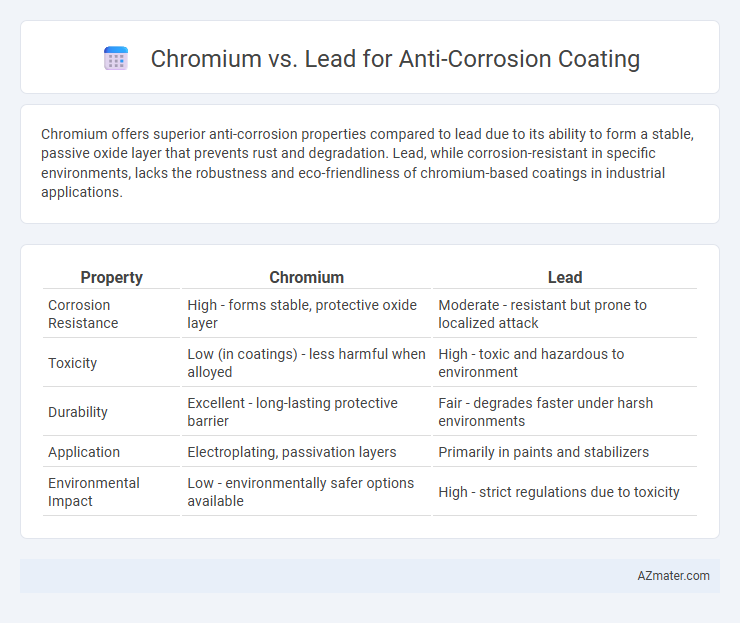Chromium offers superior anti-corrosion properties compared to lead due to its ability to form a stable, passive oxide layer that prevents rust and degradation. Lead, while corrosion-resistant in specific environments, lacks the robustness and eco-friendliness of chromium-based coatings in industrial applications.
Table of Comparison
| Property | Chromium | Lead |
|---|---|---|
| Corrosion Resistance | High - forms stable, protective oxide layer | Moderate - resistant but prone to localized attack |
| Toxicity | Low (in coatings) - less harmful when alloyed | High - toxic and hazardous to environment |
| Durability | Excellent - long-lasting protective barrier | Fair - degrades faster under harsh environments |
| Application | Electroplating, passivation layers | Primarily in paints and stabilizers |
| Environmental Impact | Low - environmentally safer options available | High - strict regulations due to toxicity |
Introduction to Anti-corrosion Coatings
Anti-corrosion coatings are essential for protecting metal surfaces from degradation caused by environmental factors such as moisture, chemicals, and oxidation. Chromium-based coatings provide excellent hardness, wear resistance, and corrosion resistance, making them suitable for industrial applications requiring durability. Lead coatings, while historically used for corrosion protection due to their chemical inertness, are largely phased out due to toxicity concerns and environmental regulations.
Overview of Chromium-Based Coatings
Chromium-based coatings offer superior corrosion resistance by forming a dense, adherent oxide layer that protects underlying metal surfaces in harsh environments. These coatings exhibit excellent hardness and wear resistance, making them ideal for industrial applications requiring durability and long-term protection. Compared to lead-based coatings, chromium alternatives provide environmentally safer solutions without sacrificing performance in anti-corrosion applications.
Lead-Based Coatings: An Overview
Lead-based coatings have historically been used for their excellent corrosion resistance and durability, particularly in industrial environments exposed to harsh chemicals and moisture. Despite their effectiveness, lead coatings pose significant health and environmental risks due to lead's toxicity and potential for bioaccumulation. Regulatory restrictions and advancements in alternative materials have driven a decline in lead-based coatings, promoting safer, eco-friendly corrosion protection technologies.
Corrosion Resistance Performance Comparison
Chromium offers superior corrosion resistance compared to lead due to its ability to form a dense, stable oxide layer that protects underlying materials from oxidation and environmental degradation. Lead, while providing some corrosion resistance, particularly in acidic environments, lacks the durability and protective film formation of chromium, resulting in lower long-term performance. Chromium coatings exhibit enhanced resistance to harsh chemicals, high temperatures, and mechanical wear, making them the preferred choice for industrial anti-corrosion applications.
Environmental and Health Impacts
Chromium, especially hexavalent chromium, poses significant health risks including respiratory issues and carcinogenic effects, while lead exposure is linked to neurological damage and developmental disorders. Environmentally, lead accumulation contaminates soil and water, causing long-term ecological harm, whereas chromium, depending on its valence state, can be highly toxic to aquatic life and bioaccumulate in organisms. Safer alternatives and stringent regulations emphasize reducing both chromium and lead use in anti-corrosion coatings to mitigate severe environmental and human health impacts.
Application Methods and Surface Preparation
Chromium-based coatings typically require advanced application methods such as electroplating or physical vapor deposition (PVD), which ensure uniform, dense layers that provide superior anti-corrosion resistance. Lead coatings, often applied via hot-dip or thermal spraying, demand thorough surface preparation including grit blasting and degreasing to enhance adhesion and corrosion protection. Proper surface roughness and cleanliness are critical for both materials to maximize coating performance and longevity in harsh environments.
Durability and Longevity of Coatings
Chromium-based anti-corrosion coatings exhibit superior durability due to their excellent hardness and resistance to oxidation, significantly extending the lifespan of coated materials. Lead coatings provide effective corrosion resistance in specific environments but tend to degrade faster under mechanical stress and UV exposure, limiting their longevity. The inherent stability of chromium compounds ensures prolonged protection, making them a preferred choice for heavy-duty industrial applications requiring long-term corrosion prevention.
Regulatory Compliance and Restrictions
Chromium-based coatings, especially hexavalent chromium, face stringent regulatory restrictions due to their carcinogenic and environmental hazards, leading to widespread bans and strict limits under regulations like REACH and RoHS. Lead coatings also encounter significant regulatory pressure owing to toxicity concerns and heavy metal restrictions, resulting in limited use and enforced phase-outs in many industries. Compliance challenges favor the adoption of safer alternatives such as trivalent chromium or lead-free systems that meet both environmental and health safety standards globally.
Cost Analysis and Economic Considerations
Chromium-based anti-corrosion coatings typically incur higher initial costs due to raw material prices and complex application processes compared to lead-based coatings, which are cheaper but pose significant environmental and health risks. Economic considerations must include long-term expenses such as regulatory compliance, disposal, and potential liabilities associated with lead, often making chromium coatings more cost-effective over the asset's lifecycle. The total cost of ownership favors chromium coatings in industries prioritizing sustainability and regulatory adherence despite the upfront expense.
Future Trends in Anti-corrosion Coating Technologies
Emerging anti-corrosion coating technologies are progressively shifting from lead-based solutions to chromium alternatives due to environmental and health concerns. Innovations in nano-structured chromium coatings offer enhanced corrosion resistance, durability, and eco-friendliness compared to traditional lead coatings. Future trends highlight the integration of smart coatings with self-healing properties and reduced toxicity, positioning chromium-based materials as a sustainable choice for industrial applications.

Infographic: Chromium vs Lead for Anti-corrosion Coating
 azmater.com
azmater.com